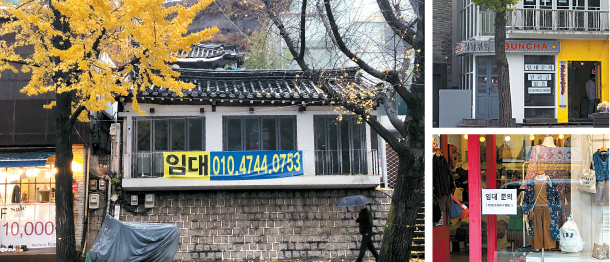Prices drive the culture out of Seoul’s cultural hub

Clockwise from left: One commercial building located in Samcheong-dong, Jongno District, that has been empty for months displays a banner that reads “For Lease.” A former restaurant advertises that no premium will be charged to a new tenant for securing the lease. A clothing and accessory shop displays a “For Lease” sign. [CHANG CHUNG-HOON]
Today, instead of being filled with tourists, many of Samcheong-dong’s commercial buildings are unoccupied. Some stores appear to have been vacated in a rush and the scattered pieces of furniture inside add a sense of eeriness to the sparsely populated neighborhood.
Just a few years ago, people flocked to Samcheong-dong, an area just north of the famous Gyeongbok Palace, to enjoy a glass of wine inside a remodeled hanok, a traditional Korean house, or visit modern galleries and listen to old Korean hits at a bar.
Samcheong-dong’s development from a humble residential neighborhood into a cultural hub began in the early 2000s, when galleries and art museums moved in and the government embarked on a large-scale renovation project to restore the terracotta roof-tiled Korean houses in the region. The face-lift attracted artists from neighboring Insa-dong, who were trying to escape the rising rent and influx of large franchises there.
The five years following 2010 were the heyday of Samcheong-dong. With its hip art galleries and unique blend of the traditional and modern, the region became a mecca for bloggers and a must-visit attraction for tourists hailing from Japan and China.
“In the past, the area overflowed with tourists on both weekdays and weekends,” said Lee Won-shik, the head of Samcheong-dong Community Service Center. “Nowadays, I’m astonished at how empty the streets are, even on the weekends.”
Today, franchises are crowding out the area, with coffee shops like Starbucks and makeup stores like Aritaum and It’s Skin threatening to turn Samcheong-dong into another shopping district. This has not only led to a huge surge in rent prices, but a fall in the number of customers visiting the area in search of a cultural experience.
"Some of the property here now sells for 70 to 80 million won ($61,640) per pyeong (35.6 square feet), with monthly rent often exceeding 10 million won,” said Lee Jae-bok, a realtor in the neighborhood.
The rent for commercial property in Samcheong-dong is much higher than the average for Jongno District. Currently, the rent for a 33-square-meter (355-square-foot) shop is priced at 1.46 million won, while the district average is 1.2 million won, according to the Jongno District Office. At the same time, the cafes and restaurants in Samcheong-dong earn around 10 million won less per month compared to the district average.
Discouraged shopkeepers are packing their bags and looking to move out, unable to keep up with rising rent and falling profit.
“I used to earn 50 to 60 million won in monthly sales four or five years ago, but now I barely earn 30 million won,” said Lee Won-hee, who runs a clothing shop in Samcheong-dong. “I’ve put my property on sale, but I haven’t been able to find any buyers yet.”
Local merchants complain that their landlords don’t understand the neighborhood.
“Many of the landlords are not from the area, so they don’t really have an emotional connection with Samcheong-dong,” said a local merchant. “They only care about maximizing profit, not about whether the area prospers.”
While the government has taken action to address shopkeepers’ concerns, its efforts have not brought about many visible results. Last month, landlords failed to show up to a meeting organized by the Jongno District Office to give tenants and landlords an opportunity to discuss rent issues together.
Samcheong-dong is not alone in experiencing this pattern of development, boom and soaring rent in Seoul. Insa-dong’s streets are now filled with souvenir shops stockpiled with goods made in China, while the high rent in Gangnam District’s Apgujeong-dong and Itaewon’s Gyeongnidan-gil have seen franchises replace independent stores there as well.
Tensions between one tenant and a landlord boiled over to violence in June, causing the issue of high rent to resurface in the media and political discussions.
The owner of a pig trotter restaurant in Seochon, another popular area in Jongno District, attacked his landlord with a hammer after being charged a monthly rent of 12 million won ($10,700), over four times what the previous landlord had asked for.
“Rent prices need to be flexible to allow new shops to open and attract new customers for a commercial district to thrive,” advised analyst Lee Sang-hyuk of the Sangga Research & Review Lab.
“Due to heightened competition, commercial districts need to offer experiences and goods unavailable anywhere else,” said Prof. Mo Jong-ryn, who teaches international political economy at Yonsei University. “Samcheong-dong can only prosper if it can bring in innovative shops that incorporate the region’s existing resources like art museums, galleries and hanok.”
BY CHANG CHUNG-HOON AND KIM YOUNG-JU [kim.eunjin1@joongang.co.kr]










with the Korea JoongAng Daily
To write comments, please log in to one of the accounts.
Standards Board Policy (0/250자)